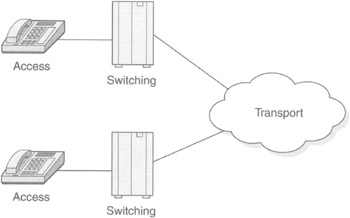Chapter 6: Voice over 802.11
|
|
The greatest test 802.11 will have to face when being compared to the Public Switched Telephone Network (PSTN) is its capability to transmit voice with the clarity of the PSTN. The immediate assumption is that the quality of service (QoS) of an 802.11 network is inadequate for voice transmission. As demonstrated in the previous chapter, QoS on 802.11 networks can be engineered to equal that of wired networks. Its wide acceptance in enterprise networks is testimony to this. This chapter explores how voice becomes data in voice over Internet Protocol (VoIP) and that 802.11 is wireless IP; therefore, VoIP can travel over 802.11, delivering voice with a quality equal to that of the PSTN.
The threat to telephone companies is that it is infinitely cheaper to beam data (and voice) to customers than it is to run a copper wire or coaxial cable to them. In addition, the potential data flow to a subscriber over an 802.11 network is exponentially greater than that of the 56 Kbps delivered via a telco's copper-wire dial-up connection. The emergence of softswitch as a switching alternative to Class 4 and Class 5 switches makes it all the more feasible for 802.11 service providers to offer voice services independent of the telephone company or for subscribers (especially enterprises) to be their own telephone company, effectively bypassing the PSTN entirely.
PSTN Architecture
The PSTN, over which the vast majority of the voice traffic in North America travels, is comprised of three elements. The first is transport, or the transportation of conversation from one central office to another. The second is a telephone switch contained in the central office. A switch provides switching, or the routing of calls, in the PSTN. Finally, access denotes the connection between the switch in the central office and the subscriber's telephone or other telecommunications device. Figure 6-1 provides an overview of this architecture.

Figure 6-1: The three components of the PSTN- access, switching, and transport
As illustrated in Figure 6-2, 802.11 is a form of access to a wider network (the PSTN, a corporate local area network [LAN] or the wide area network [WAN], or the Internet). The Memorandum of Final Judgment (MFJ) of 1984 opened transport to competition. The "bandwidth glut" at the time of this writing has made transport relatively inexpensive. Softswitch technologies (such as IP private branch exchange [PBX] or Class 4 and 5 replacements) offer a viable alternative to the switching facilities of the PSTN. The Telecommunications Act of 1996 was to have opened the switching and access facilities of the PSTN to competition. For a number of reasons, this has not happened. 802.11 presents a bypass technology of the telco's copper-wire access.

Figure 6-2: An alternative to the PSTN- 802.11 for access, softswitch for switching, and IP backbone for transport
|
|
EAN: 2147483647
Pages: 96